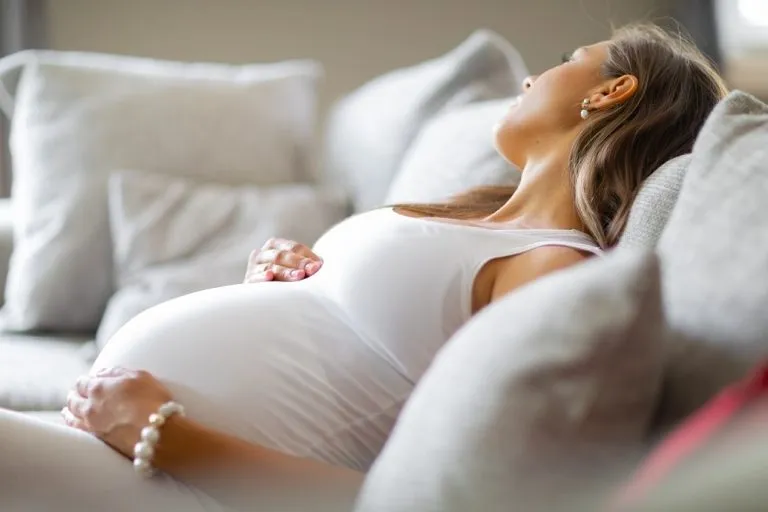Parents wait impatiently until they feel their baby's first movements. These are moments that provide many emotions, but also build a strong bond between the child and Parents. In monitoring fetal well-being, it is very important for the mother to observe and count the baby's movements. So at what week of pregnancy can you feel the baby's movements?
How to recognize the first movements of the baby in the abdomen?
The baby’s movements in the abdomen can be felt very differently. Women who have never given birth before expect strong kicks, meanwhile, the baby’s first movements usually resemble the fluttering of butterfly wings. Intense movements of the baby that take the form of kicks and cause discomfort, appear only before birth. However, the intensity and frequency of the movements depend on how the baby is positioned in the uterus. The intensity of sensation is also affected by pre-pregnancy weight and the amount of body fat – the first movements of the baby are felt earlier by women who are petite and thin.
When do you feel the first movements of the baby during pregnancy?
The child along with 15. In the fetal weeks, it makes complex movements with its limbs. However, they are so small that this activity is usually not felt by the mother-to-be. As late as the 16th. A week of pregnancy can cause the first movements of the baby, but women usually feel the first movements of the fetus around 20. of the week. Moms-to-be compare them to the peristaltic movements of the intestines. It is a gentle overflow and bubbling. If it is another pregnancy, fetal movements may be felt earlier – between 15. a 18. week of pregnancy. As the weeks go by, they become more intense and regular.
At the end of pregnancy, the baby is already large, and fetal movements become gentle again. However, they are extremely important, as they testify to the well-being of the fetus and its proper development.
What do the baby’s first movements look like and are they regular?
Sensing the baby’s first movements is not so easy, especially when a woman is pregnant for the first time and when she only imagines what it feels like. The easiest way to feel the movements is in the supine position, in complete stillness. At that time, we do not focus on any activities and it is easier to register the signals coming from the body.
Each toddler has its own rhythm of the day, with some children making themselves known early in the morning, others in the evening. Usually the baby’s first movements become more intense after eating a meal. The baby’s motor activity in mom’s belly is an indication of its normal development. Such follies also allow the baby to prepare for the difficult journey of getting through the birth canal.
How does the baby in mom’s belly behave?
The baby in mom’s belly makes all sorts of movements. He flexes and straightens his limbs, does flips, sucks his finger, and yawns. Often during the ultrasound, you will notice how the baby makes different faces, there is a grimace or a smile on his face. Recently, 3D and 4D ultrasound examinations have become increasingly popular, allowing Parents to see their baby in detail and keep photos or video as a keepsake.
Elements related to the child’s activity are also assessed during the Manning test, or so-called “activity test. fetal biophysical profile. It is performed most often in III. trimester or after the date of delivery. The test consists of a combined ultrasound and OCT. During the ultrasound examination, the following are assessed. breathing movements and how the fetus moves in the mother’s abdomen. The Manning test is designed to assess a child’s well-being. An abnormal test result may indicate that it is hypoxic.
Very busy baby in the belly
The activity of the baby in the mother’s belly increases especially after meals and when the pregnant woman is resting or sleeping. Interestingly, the baby’s first movements are felt more strongly by women with less body fat. The child also moves more intensely in response to, for example, loud music outside. Mom’s emotions also play an important role and influence the activity of the baby in the belly.
Babies in the belly, on the other hand, do not move during their sleep. Their sleep usually lasts about 40 minutes, rarely exceeding 1.5 hours. If your baby is very mobile, light rocking and walking will have a soothing effect. Some mothers, wanting to soothe the baby in their bellies, also listen to classical music. This is because it is believed that the fetus begins to respond to external sounds as early as 25. One week of pregnancy.
How to count the baby’s movements before delivery?
Especially in the second half of pregnancy, it is extremely important to count fetal movements on a daily basis. Thus, independently at home, a woman can monitor the well-being of the fetus. Ideally, a pregnant woman should count movements for an hour after a meal or during the baby’s peak activity. The mother-to-be should do this while lying on her left side. If the baby’s movements are less than 4 in one hour, doctors recommend counting them for another hour.
Some recommendations state to count the baby’s movements until the number reaches 10. This is the so-called. Cardiff method, during which the number of movements between 9 a.m. and 9 p.m. is checked. This activity is repeated every day, and counts until the child moves 10 times. A fetal movement chart can also be used to assess movements. No movement of the baby at 22. week of pregnancy should be a signal to go to the attending physician.
In what month do you feel the baby’s movements as kicks?
In order for the baby to kick or push against the uterine walls, it needs to be bigger and stronger than it is at around 20. One week of pregnancy. The child kicks no earlier than after 26. Week, and thus at the end of the 6th. of the month. The mother-to-be may feel the intense activity of the baby and feel general discomfort, and it is also possible to have individual pushes that cause a feeling of tension in a particular part of the abdomen or even tension in the entire uterus. With such single pushes, the toddler can even show his hand or foot! The phenomenon when a hand or foot stands out under the skin on the abdomen is quite popular among pregnant women. Observing this phenomenon for the first time is usually a great experience for Parents!
Toward the end of pregnancy, mothers-to-be experience the most discomfort from the baby’s movements. No wonder – it’s already getting really tight in mom’s belly, so the baby’s movements at 9. Months, even gentle ones, are perfectly felt by the mother.
How to stimulate the baby’s movements during pregnancy?
- Knocking on the belly and talking – when the baby kicks, it’s a good idea to respond with a gentle knock on the belly. It is also a good idea to introduce speech. At the end of the third trimester, although the child does not understand speech, but is able to recognize and identify it.
- Rocking and turning on music – turning on music for the baby and attaching headphones or a speaker to the belly can get the baby accustomed to environmental sounds. The mother’s intense movements, in turn, make the baby more agitated. Calm movements, as well as lying on the left side, are information for the toddler about the time for rest.
- Eating sweets and laughing – higher blood glucose levels stimulate the child to be more active, but sweet snacks should be taken in moderation. A mother’s laughter is also a good way to stimulate the baby. This activity improves blood circulation and oxygenation. It is common for the mother’s laughter during the ultrasound to reinforce the baby’s movements.
FAQ:
- At what week do you feel the baby’s movements?
In order to recognize the baby’s movements in the form of gentle bubbling, tickling or a feeling of overflowing in the abdomen, the pregnant woman will have to wait until at least the 16th. One week of pregnancy. However, it happens that the first sensations occur later, even at 22. One week of pregnancy.
- When can you see the baby’s outward movements?
The baby’s most intense movements are usually observed between 7. and the 8th month of pregnancy. When the fetus makes strong kicks or pushes in the uterus with its hands, you can see it on the outside.
- Where can I feel the baby’s first movements?
The baby’s first movements can be felt at different heights depending on the position of the baby and the placenta, but most often women sense them low in the abdomen, just above the underwear line.
Rate this article:










